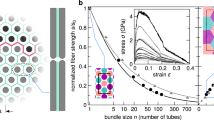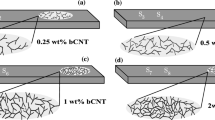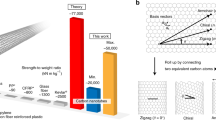Abstract
Polymer composites reinforced by carbon nanotubes have been extensively researched1,2,3,4 for their strength and stiffness properties. Unless the interface is carefully engineered, poor load transfer between nanotubes (in bundles) and between nanotubes and surrounding polymer chains may result in interfacial slippage1,2 and reduced performance. Interfacial shear, although detrimental to high stiffness and strength, could result in very high mechanical damping, which is an important attribute in many commercial applications. We previously reported5 evidence of damping in nanocomposites by measuring the modal response (at resonance) of cantilevered beams with embedded nanocomposite films. Here we carry out direct shear testing of epoxy thin films containing dense packing of multiwalled carbon nanotube fillers and report strong viscoelastic behaviour with up to 1,400% increase in loss factor (damping ratio) of the baseline epoxy. The great improvement in damping was achieved without sacrificing the mechanical strength and stiffness of the polymer, and with minimal weight penalty. Based on the interfacial shear stress (∼0.5 MPa) at which the loss modulus increases sharply for our system, we conclude that the damping is related to frictional energy dissipation during interfacial sliding at the large, spatially distributed, nanotube–nanotube interfaces.
This is a preview of subscription content, access via your institution
Access options
Subscribe to this journal
Receive 12 print issues and online access
$259.00 per year
only $21.58 per issue
Buy this article
- Purchase on Springer Link
- Instant access to full article PDF
Prices may be subject to local taxes which are calculated during checkout




Similar content being viewed by others
References
Shadler, L. S., Giannaris, S. C. & Ajayan, P. M. Load transfer in carbon nanotube epoxy composites. Appl. Phys. Lett. 73, 3842–3844 (1998).
Ajayan, P. M., Shadler L. S., Giannaris C. & Rubio, A. Single-walled carbon nanotube–polymer composites: strength and weakness. Adv. Mater. 12, 750–753 (2000).
Wagner, H. D., Lourie, O., Feldman, Y. & Tenne, R. Stress-induced fragmentation of multiwall carbon nanotubes in a polymer matrix. Appl. Phys. Lett. 72, 188–190 (1998).
Thostenson, E. T. & Chou, T.-W. Aligned multi-walled carbon nanotube-reinforced composites: processing and mechanical characterization. J. Phys. D 35, 77–80 (2002).
Koratkar, N., Wei, B. & Ajayan, P. M. Carbon nanotubes for damping applications. Adv. Mater. 14, 997–1000 (2002).
Biggerstaff, J. M. & Kosmatka, J. B. Damping performance of cocured graphite/epoxy composite laminates with embedded damping materials. J. Compos. Mater. 33, 1457–1469 (1999).
Kosamata, J. B. & Liguore, S. L. Review of methods for analyzing constrained layer damping structures. J. Aerospace Eng. 6, 268–283 (1993).
Baz, A. & Ro, J. The concept and performance of active constrained layer damping treatments. J. Sound Vibrat. 28, 18–21 (1994).
Liao, W. H. & Wang, K. W. On the analysis of viscoelastic materials for active constrained layer damping treatments. J. Sound Vibrat. 207, 319–334 (1997).
Liao, W. H. & Wang, K. W. Characteristics of enhanced active constrained layer damping treatments with edge elements. J. Vibrat. Acoust. 120, 886–893 (1998).
Liu, Y. & Wang, K. W. A non-dimensional parametric study of enhanced active constrained layer damping treatments. J. Sound Vibrat. 223, 611–644 (1999).
Thostenson, E. T., Zhifeng, R. & Chou, T.-W. Advances in the science and technology of carbon nanotubes and their composites: a review. Compos. Sci. Technol. 61, 1899–1912 (2001).
Li, F., Cheng, H. M., Bai, S., Su, G. & Dresselhaus, M. S. Tensile strength of single-walled carbon nanotubes directly measured from their macroscopic ropes. Appl. Phys. Lett. 77, 3161–3163 (2000).
Barber, A., Cohen, S. & Wagner, H. D. Measurement of carbon nanotube–polymer interfacial strength. Appl. Phys. Lett. 82, 4140–4142 (2003).
Zhou, X., Shin, E., Wang, K. W. & Bakis, C. E. in ASME Intl Design Engineering Technical Conf. (ASME, Chicago, 2003).
Zhou, X., Wang, K. W. & Bakis, C. E. in SPIE Intl Symp. Smart Structures and Materials: Damping and Isolation Conf. 5386–18 (SPIE, San Diego, 2004).
Wei, B., Zhang, Z., Ramanath, G. & Ajayan, P. Lift-up growth of patterned aligned carbon nanotubes. Appl. Phys. Lett. 77, 2985–2987 (2000).
Wei, B. et al. Organized assembly of carbon nanotubes. Nature 416, 495–496 (2002).
Kelly, B. T. Physics of Graphite (Applied Science, London, 1981).
Painter, P. & Coleman M. Fundamentals of Polymer Science (CRC, New York, 1997).
Yu, M. F., Yakobson, B. I. & Ruoff, R. S. Controlled sliding and pullout of nested shells in individual multiwalled carbon nanotubes. J. Phys. Chem. B 104, 8764–8767 (2000).
Cumings, J. & Zettl, A. Low-friction nanoscale linear bearing realized from multiwalled carbon nanotubes. Science 289, 602–604 (2000).
Liao, K. & Li, S. Interfacial characteristics of a carbon nanotube–polystyrene composite system. Appl. Phys. Lett. 79, 4225–4227 (2001).
Acknowledgements
N.K. and P.A. acknowledge funding support from the US National Science Foundation (Faculty Early Career Development Award and NSEC Center for Directed Assembly of Nanostructures Award) and the US Army Research Office through the Structures and Dynamics Program. PK was supported by NSF grant DMR 134725.
Author information
Authors and Affiliations
Corresponding author
Ethics declarations
Competing interests
The authors declare no competing financial interests.
Rights and permissions
About this article
Cite this article
Suhr, J., Koratkar, N., Keblinski, P. et al. Viscoelasticity in carbon nanotube composites. Nature Mater 4, 134–137 (2005). https://doi.org/10.1038/nmat1293
Received:
Accepted:
Published:
Issue Date:
DOI: https://doi.org/10.1038/nmat1293
This article is cited by
-
Magnetized radiative flow of propylene glycol with carbon nanotubes and activation energy
Scientific Reports (2023)
-
Ultrahigh energy-dissipation elastomers by precisely tailoring the relaxation of confined polymer fluids
Nature Communications (2021)
-
The influence of the negative wake on the deformation and breakup of viscoelastic droplets
Korea-Australia Rheology Journal (2021)
-
Experimental and Numerical Sensitivity Assessment of Viscoelasticity for Polymer Composite Materials
Scientific Reports (2020)
-
Graphene Size and Morphology: Peculiar Effects on Damping Properties of Polymer Nanocomposites
Experimental Mechanics (2020)



